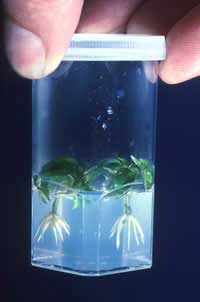 Wild Cherry improvement at EMR
Wild Cherry improvement at EMR
Wild Cherry was selected as a model species for improvement as it has many desirable characteristics (see introduction). In addition, we were able to apply our knowledge and experience of sweet cherry (also P. avium) and benefit from the short generation time (~ four years) and the relatively small genome, making it ideal for genetic mapping.
The aim of the wild cherry improvement programme is to produce vigorous, well-formed trees with resistance pests and diseases, especially cherry blackfly and bacterial canker. The breeding programme combines both conventional and molecular techniques.
There are several stages to the programme:
Collection
The collection of graftwood from ‘plus’ trees, i.e. phenotypically superior, mature trees in the wild, and the establishment of a type collection of parental trees comprise the first stage of the improvement programme, whether for the controlled crossing programme, for selection and trialling or for the creation of seed orchards.
Breeding
Trees with desirable characters such as good vigour and form, and resistance to bacterial canker or cherry blackfly, are selected as parents for the breeding programme. Three main types of controlled crosses, in which pollen is taken from one tree and applied to the flowers of another, are made. In the first, both parents are wild cherry (intraspecific); in the second, one parent is a wild cherry and the other a different cherry species (interspecific); and, in the third, a normal diploid wild cherry is crossed with a tetraploid cherry with twice the normal number of chromosomes, to produce triploid seedlings. Two additional types of cross have also been made. A selected interspecific seedling with good form and resistance to cherry blackfly was ‘backcrossed’ to wild cherry to introgress the resistance into P. avium. In the second cross, pollen was taken from an asiatic Prunus species and applied to the flowers of a tetraploid wild cherry, to produce interspecific triploids. These will be sterile and incapable of crossing with the native wild cherry, thus avoiding genetic “pollution”. All crosses were made in insect-proof and frost-proof glasshouses or with the use of pollination bags in the field.
Genetics
In genetic mapping, we detect molecular markers (proteins and DNA which are easily scored in the laboratory) that are co-inherited with – i.e. genetically linked with – important agronomic and morphological characters. At East Malling, we have raised progenies of known parentage that are segregating for characteristics of interest. These characters have been recorded in the field and the molecular markers have been scored in the laboratory. By comparing the field and laboratory data we can determine which characters and markers are inherited together and thus create a genetic map on which genes for field characters are located.
Trials
Before planting in the type collection, ‘plus’ trees are tested for the absence of viral infections which can cause detrimental effects. They are then assessed in the field collection for vigour, form, and resistance to pest and diseases. The best are propagated and planted in replicated trials for further study. The first trials were planted in 1992 further trials were established in 1995, 1998 and 2002. The later trials include seedling selections from the controlled breeding programme.
Seed orchards
Currently, the industry has to rely on seedlings of unknown merit for planting stock. To address this problem, EMR has established three clonal seed orchards, one comprising clones from across England, one with clones from SE England and the other with clones from SW England and Wales. The orchards are designed to maximise cross-pollination and thus yield of seed. This was possible as a laboratory technique had been developed at EMR to identify cherry incompatibility groups. These orchards will provide seed of UK origin, from trees selected for their excellent phenotypes. Seed is already being produced by two of the seed orchards and the third orchard should produce its first seed crop this year.
Achievements
- Collection of over 150 UK plus trees established
- Over 6000 seedlings raised from the controlled breeding programme -these under evaluation
- Seedlings with resistance to cherry blackfly, cherry leaf scorch and cherry leaf spot identified
- 9 clonal trials established around the country
- First 10 wild cherry clones selected for good form and vigour and resistance to bacterial canker released under the name WildstarTM (further selections are planned in due course)
- Three clonal seed orchards established
- Genetic map for cherry created with markers located for several major genes (dwarf and albino) and quantitative traits such as bud burst and wood quality
- Molecular markers (SSRs) developed to study diversity in cherry
Population Structure and Geneflow in wild cherry
In addition to the improvement work, EMR has completed a study of population structure and geneflow in two native, semi-ancient populations of wild cherry with contrasting management regimes and a farm woodland planting (12 years of age). This work has found that spatial genetic structure in cherry is amongst the strongest reported for tree species and that management regimes significantly influence population structure. Asexual reproduction (suckering) accounted for a significant proportion of wild cherry recruitment, with approximately half and two-thirds of trees belong to clonal groups in the managed and unmanaged populations, respectively. The maximum clonal group size recorded exceeded 800m2. Approximately a third of embryos were fathered by trees occurring within 50m from the mother (seed) trees, a further third were father by trees within the woodland with the most distant father being at least 800m away, and the remaining third fathered by trees outside of the woodlands studied.
These results have implications for the selection and management of plus trees and seed stands (suggest minimum of 160m between trees/groups) and site selection for seed orchards (suggest minimum distance of 800m from other cherry trees). Papers describing the work in full should be published in 2006.
